- Quick Read
- Deep Read ( 6 Min. )
In Today’s Issue
- Biden and Netanyahu – and the diminished US standing in Middle East
- Today’s news briefs
- Trump vs. Harris? In Florida, abortion is biggest ballot question.
- A French rape victim goes public. She makes ‘shame change sides.’
- Hurricane Milton: Even a sea turtle is part of Tampa’s evacuation
- Dropping the ‘senior’ in senior center
Monitor Daily Podcast
- Follow us:
- Apple Podcasts
- Spotify
- RSS Feed
- Download
TODAY’S INTRO
Rebranding senior centers, redefining age
 Mark Sappenfield
Mark Sappenfield
Taking the word “senior” out of senior centers might seem a rather superficial and transparent change. But it isn’t.
Today, Ashley Milne-Tyte shows that senior centers across the United States aren’t just being rebranded; they’re being transformed, because our sense of age is being transformed. Today’s seniors are active and curious. Why shouldn’t the ecosystems around them be, too?
It’s not really about taking one word out. It’s about pouring more life in.
Share this article
Link copied.

Help fund Monitor journalism for $11/ month
Already a subscriber? Login

Monitor journalism changes lives because we open that too-small box that most people think they live in. We believe news can and should expand a sense of identity and possibility beyond narrow conventional expectations.
Our work isn't possible without your support.
Biden and Netanyahu – and the diminished US standing in Middle East
For the past year of war in the Middle East, many critics of the Biden administration at home and abroad say its inability to restrain Israeli Prime Minister Benjamin Netanyahu has damaged U.S. stature and credibility in the region.

As Washington and other world capitals wait to see how Israel will retaliate for Iran’s Oct. 1 missile attack, there’s a strong sense of not knowing exactly what to expect.
While global markets are already anticipating that Israel will go after Iran’s vast oil production infrastructure, U.S. officials are more worried that Israel will try to bomb Iran’s nuclear facilities.
President Joe Biden has publicly cautioned Israel against attacking Iran’s nuclear sites – a move U.S. officials worry could provoke a cataclysmic response from Tehran.
But the world has observed Prime Minister Benjamin Netanyahu repeatedly disregarding and disparaging U.S. counsel over the past year of war in Gaza, and now Lebanon, some experts say.
“Netanyahu has time and again demonstrated to the world that one could not only stiff-arm the U.S., but could repeatedly leave it in the dark on its actions and openly lie about what the U.S. was doing [for example, regarding arms deliveries] – and do so with impunity,” says Jon Alterman, director of the Middle East program at the Center for Strategic and International Studies in Washington.
“That’s not a very useful lesson for the world to learn,” he says.
Biden and Netanyahu – and the diminished US standing in Middle East

President Joe Biden was asked last week if he thought Israeli Prime Minister Benjamin Netanyahu was deliberately acting in ways to sway the U.S. presidential election.
His strikingly passive response, clearly tinged with disappointment, communicated much more than a simple answer to the question.
“Whether he’s trying to influence the election, I don’t know,” said Mr. Biden, before adding that, in any case, Mr. Netanyahu should remember that “no administration has done more for Israel than I have. None, none, none.”
He was the first U.S. president to visit Israel in wartime, having arrived in Tel Aviv just days after the shocking Hamas attacks of Oct. 7 to wrap the Israeli leader (and all Israel, collectively) in an “unshakable” embrace of American support.
And yet here was Mr. Biden in the White House briefing room a year later, unsure of the Israeli leader’s objectives. His uncertainty underscored how for months the United States had repeatedly been left in the dark on Israeli escalatory actions in Gaza, against Hezbollah in Lebanon, and now over Israel’s anticipated retaliation against Iran.
More than anything, Mr. Biden’s words underscored how little sway the U.S. has over players and events in the region, and just how diminished U.S. standing is.
“Who knows what’s next?”
That President Biden couldn’t reject the possibility that Mr. Netanyahu wants to influence the U.S. election “suggests to me that the U.S. is not in the driver’s seat here,” says Rosemary Kelanic, director of the Middle East program at Defense Priorities, a Washington think tank that promotes restraint and focus on core interests in U.S. foreign policy.
“Not only is the U.S. just along for the ride, but it doesn’t even know where the destination is.”
Noting the number of instances over the past year in which Israel reportedly gave the U.S. no advance notice of potentially escalatory actions – including last month’s pager attacks in Lebanon and the bombing in Beirut that killed Hezbollah leader Hassan Nasrallah – she says this situation “reveals just how little leverage the U.S. has” with Israel.
“From the U.S. perspective,” she adds, “who knows what’s next?”

That question is echoing across Washington and other capitals as the world waits to see how Israel will deliver its promised retaliation against Iran for its Oct. 1 missile attacks on Israel.
While global markets are already anticipating that Israel will go after Iran’s vast oil-production infrastructure – world oil prices have shot up this week – U.S. officials are more worried that Israel will try to bomb Iran’s nuclear facilities.
Most military experts believe Israel could not significantly damage Iran’s deeply buried nuclear installations without U.S. military assistance.
Mr. Biden has publicly cautioned Israel against attacking Iran’s nuclear sites – a move U.S. officials worry could provoke a cataclysmic response from Tehran.
But the world has observed Mr. Netanyahu repeatedly disregarding and disparaging U.S. counsel over the past year, some experts say. They warn that the spectacle has damaged U.S. stature and credibility among friends and adversaries alike.
“Netanyahu has time and again demonstrated to the world that one could not only stiff arm the U.S., but could repeatedly leave it in the dark on its actions and openly lie about what the U.S. was doing [for example, regarding arms deliveries] – and do so with impunity,” says Jon Alterman, director of the Middle East program at the Center for Strategic and International Studies in Washington.
“That’s not a very useful lesson for the world to learn,” says Mr. Alterman, a former special assistant to the assistant secretary of state for Near Eastern affairs.
Declining U.S. stature in Mideast
Indeed, at the recent U.N. General Assembly meeting in New York, one of the buzziest topics of hallway chatter was American impotence and inability to influence its key Middle East ally, officials from several countries report.
The past year demonstrates how profoundly the earthquake of the Oct. 7 attacks has shaken and realigned the trajectory and power balance of the Middle East. Most significant, perhaps, has been the U.S. relegation from unrivaled engine for regional action to almost observer status.
“Even if it had been possible to reach a cease-fire deal on Gaza, it would have been the result of the U.S. and Egypt and Qatar working together, so even that would have underscored how the world has changed from the days when the U.S. largely made things happen on its own,” says Bruce Jentleson, a professor of public policy and political science at Duke University in Durham, North Carolina.
Given that reality, Dr. Jentleson, a former State Department Middle East expert, says the Biden administration erred by repeatedly proclaiming its diplomatic efforts were on the verge of bearing fruit. “I never thought it was wise to say you were so, so close to completing a negotiation” for a Gaza cease-fire, he says. “Overall,” he adds, “we haven’t played our hand very well.”

And one of the biggest mistakes foreign policy experts say President Biden made was to allow his “unshakable support” for Israel blind him to the unfriendly actions and overriding political motivations of the Israeli leader.
“I don’t know what single action by the U.S. would have changed the course of this conflict,” says Dr. Alterman, “but what I do know is that the Israeli prime minister ambushed the leader of the country that has done more than any other ... to protect Israel and its interests.”
Few regional experts say the differences with Mr. Netanyahu should have prompted the U.S. to cut off military assistance to Israel. “Given the nature of Israel’s adversaries, I have a hard time with the argument the U.S. should have conditioned aid to Israel,” Dr. Alterman says.
But some argue there were ways to set a tougher tone. “There is a difference between defending Israel against its enemies, and giving them that same ironclad support for their actions in Gaza and the West Bank that we saw as contrary to our interests,” Dr. Jentleson says.
Noting that Mr. Netanyahu was actively undermining U.S. diplomatic efforts and “disparaging the administration” directly with U.S. audiences, Dr. Alterman says the Biden administration should have at least been more upfront about its differences with the Israeli leader.
Drawing an analogy to the “Marquess of Queensberry rules” that set the standards for fairness in boxing, he says, “If they were not going to play by the rules, why are we going to be polite and play by the rules? I don’t get it.”
An altered legacy
For numerous observers, America’s sidelining in the course-setting of Middle East affairs – and in particular Mr. Biden’s inability despite months of effort to deliver a cease-fire and nip an expanding conflict in the bud – underscore how profoundly things have changed in a year.
In September 2023, a commanding President Biden announced at a Group of 20 summit a Middle East trade plan that was to be one piece of a grand re-imagining of the region. The vision, seen as contrary to Iran’s or Hamas’ interests, included normalized Israeli-Saudi relations, a Palestinian state, and a U.S.-Saudi strategic partnership.
Mr. Biden dubbed the ambitious plan “an inflection point in history,” and it was widely understood that the plan would cement Mr. Biden’s legacy in the region.
Now that legacy is a shambles, and for much of the region and beyond, Mr. Biden’s Middle East legacy will be almost the contrary: an unwitting facilitation of a devastating regional conflict as a result of unquestioned support for an ally whose leader has repeatedly disregarded U.S. counsel for restraint and de-escalation.
“There’s no question that moral hazard is at work in the U.S.-Israeli relationship,” says Dr. Kelanic of Defense Priorities. “Iron-clad support for Israel … can create perverse incentives for Netanyahu to behave more aggressively [and] take greater risks knowing the U.S. has Israel’s back, perhaps no matter what.”

Today’s news briefs
• AI Nobel Prize: John Hopfield and Geoffrey Hinton are awarded the Nobel Prize in physics for discoveries and inventions that formed the building blocks of machine learning.
• Biden executive order: The U.S. Supreme Court has turned away a challenge from Republican state lawmakers in Pennsylvania to a Biden administration executive order that is intended to boost voter registration.
• TikTok lawsuits: More than a dozen U.S. states and the District of Columbia file lawsuits alleging that the popular short-form video app is harming youth mental health by designing its platform to be addictive to children.
• Lead pipe removal: A decade after the Flint, Michigan, water crisis raised alarms about the dangers of lead in tap water, President Joe Biden sets a 10-year deadline for cities in the United States to replace lead pipes.
• U.S. water system targeted: The unauthorized activity detected on Oct. 4 prompted New Jersey-based American Water, which provides services to people in 14 states, to pause billing to customers.

Trump vs. Harris? In Florida, abortion is biggest ballot question.
After the U.S. Supreme Court overturned Roe v. Wade, ballot measures supporting abortion rights helped drive turnout for Democrats in 2022. Now, a vote in Florida will test the long-term strength of that political backlash.

- Quick Read
- Deep Read ( 7 Min. )
Floridians will vote this November on a ballot measure that would guarantee abortion access up to fetal viability, about 22 to 24 weeks’ gestation – far beyond the six-week window that became state law in May.
The vote presents a key test of whether abortion-rights measures can still draw floods of voters to the polls, even in red states – or if the energy around that issue is waning.
Since the overturning of Roe v. Wade, every state ballot measure aimed at supporting abortion rights has passed, including in conservative states like Kansas, Kentucky, and Ohio. But Florida’s amendment comes with an added dimension. To pass, it must receive 60% of the vote. And as shock over the U.S. Supreme Court’s 2022 ruling fades and the patchwork of state abortion laws becomes the “new normal,” abortion foes seem to be finding their footing in fighting back.
Florida’s most famous resident – former President Donald Trump – skirted questions about Amendment 4 before finally, under pressure from anti-abortion activists, saying he would vote no.
Some Florida Republicans plan to vote for Mr. Trump and yes on Amendment 4.
“On foreign policy, I believe he projects a little more strength” than Vice President Kamala Harris, says Jared, a lawyer in Tampa who asked to withhold his last name. But on abortion, he says, “I don’t want the government to police what women can do.”
Trump vs. Harris? In Florida, abortion is biggest ballot question.
Melissa Shiff, clipboard and campaign literature in hand, strides up to a home on her list and knocks on the front door. An older man appears, sees Ms. Shiff’s “Harris Walz” T-shirt, and bristles.
“We’re Trumpers! We’re pro-life!” he declares, and then shuts the door.
Ms. Shiff, the leader of Florida Women for Harris – out canvassing in suburban Fort Lauderdale on a recent Saturday – steps back onto the driveway and pauses.
“I just wish people would be kind,” she says, shaking her head.
In these final weeks of the 2024 campaign, the marquee national contest is the presidential race between Democrat Kamala Harris and Republican Donald Trump. But here in Florida, a onetime electoral battleground that now tilts Republican, the biggest unknown heading into November isn’t about the candidates on the ballot.
It’s about abortion.
Floridians are facing a referendum that would guarantee abortion access up to fetal viability, about 22 to 24 weeks’ gestation. That’s far beyond the six-week window (before many women even know they’re pregnant) that became state law in May. To pass, the proposed state constitutional amendment needs 60% of the vote. Public polls show supporters within striking distance.
When the U.S. Supreme Court overturned the nationwide right to abortion in June 2022, the political backlash was immediate and intense. Abortion-rights advocates quickly began mobilizing around state ballot measures to ensure abortion access – and repeatedly won. Since the overturning of Roe v. Wade, every state ballot measure aimed at supporting abortion rights has passed, including in conservative states like Kansas, Kentucky, and Ohio.
Lately, however, abortion foes seem to be finding their footing in fighting back. And as shock over the Supreme Court’s ruling fades and the patchwork of state abortion laws becomes the “new normal,” it may become harder for abortion-rights activists to challenge it.
As such, Florida’s vote next month presents a key test of whether abortion-rights measures can still draw floods of voters to the polls, even in red states – or if the energy around that issue is waning. Recent polls have shown the Senate race here tightening, with national Democrats infusing cash into their effort to defeat GOP Sen. Rick Scott. Democratic nominee Debbie Mucarsel-Powell, who’s still an underdog, has made protecting abortion rights a centerpiece of her campaign. Some Floridians may choose to split their votes, backing Republicans for president and senator but voting yes on the measure known as Amendment 4.
“I can see a sizable portion of Republican women voting yes,” says Susan MacManus, a veteran Florida political analyst.
But, she adds, the opposition TV ads are “quite good,” and growing activism from Catholic and other religious organizations is bolstering that side. “Church people are high turnout voters,” Ms. MacManus says. The Latino vote is another key battleground, with both faith-based and secular activists doing outreach for and against the measure.
The impact of Hurricane Helene – and the looming threat of another hurricane – has added even more uncertainty, as large swaths of the state are focused on cleanup and the restoration of basic services. Some polling places have been damaged, and voters in affected areas may not receive mail-in ballots.
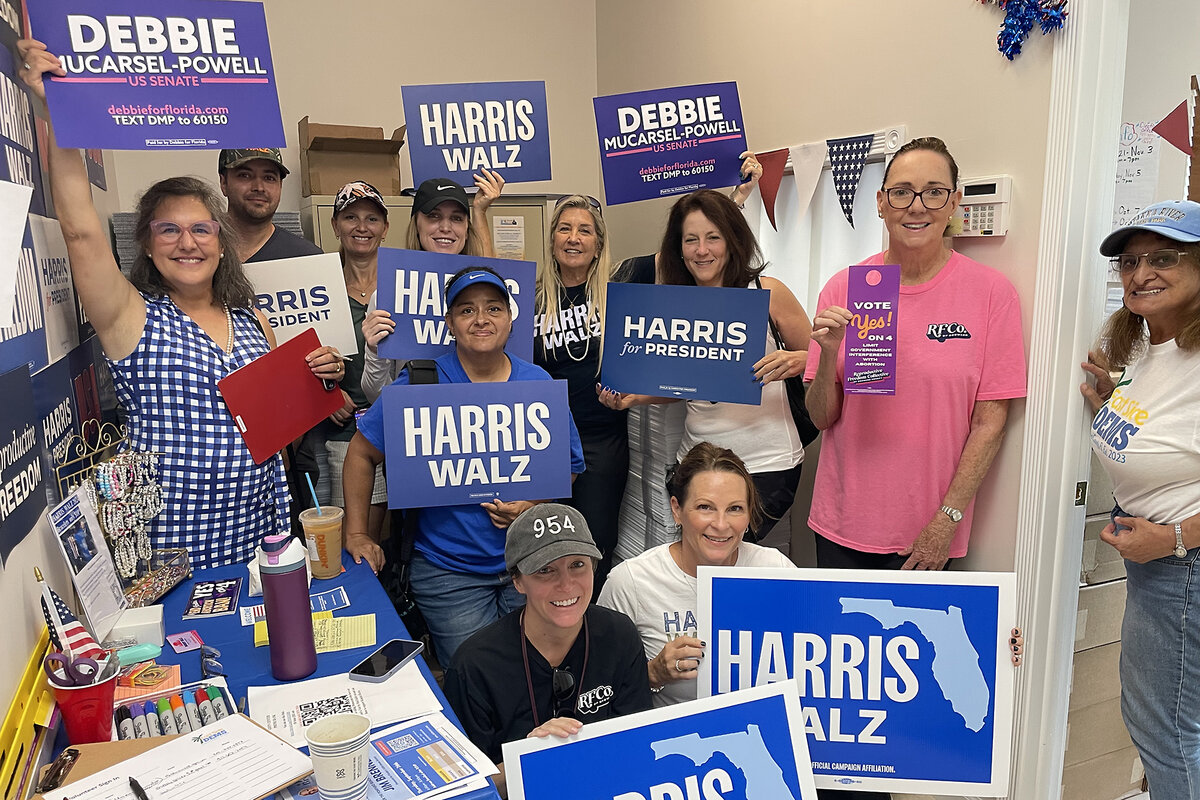
Ten abortion measures on state ballots this fall
Florida is far from alone with Amendment 4. Nine other states have constitutional amendments on the ballot this November that would ensure varying degrees of abortion access.
In key ways, however, Florida’s measure stands apart. The 60% threshold for passage is a high bar. At the same time, the nation’s third-most-populous state is a giant peninsula that can make traveling out of state for an abortion difficult – especially for women of modest means. Before the six-week ban kicked in, Florida was where women from neighboring Alabama (which has a total ban) and Georgia (whose six-week ban has been restored by the state Supreme Court while a legal challenge continues) could travel for abortions.
Millions of dollars have poured in from around the country to fund outreach by both sides in a state where campaigning is notoriously expensive – especially on TV, with 10 major media markets. Nationally, abortion-rights groups have been outraising opponents 8 to 1, according to an analysis by the watchdog group Open Secrets and The Associated Press.
Republican Gov. Ron DeSantis, a strong abortion opponent, has sparked controversy by using the tools of government in his effort to defeat the measure. In early September, at a state party dinner, he called out fellow Republicans by name who had yet to donate to the anti-Amendment 4 effort. And his secretary of state launched an investigation into signatures used to get the measure on the ballot, including signatures that had already been validated.
Most recently, the DeSantis administration successfully defended in court a website created by the state health agency claiming the amendment “threatens women’s safety.” The plaintiff, the Floridians Protecting Freedom political committee, had argued that the state “unconstitutionally entered the debate.” On Sept. 30, a Florida judge ruled the site could stay up.
Then there’s Florida’s most famous resident – former President Trump, who repeatedly skirted questions about how he would vote on Amendment 4 before finally, under pressure from anti-abortion activists, landing on his final answer: no on the amendment.
But Mr. Trump’s past comments indicated he felt otherwise. Last year, after Governor DeSantis signed the six-week ban passed by the state Legislature, Mr. Trump called it “a terrible mistake.” In late August, the former president said that a ban after six weeks was “too short” and, “I’m going to be voting that we need more than six weeks.” A day later, he reversed himself.
Mr. Trump has also said he would veto any federal abortion ban – despite the fact that he nominated the conservative justices who overturned the nationwide right to abortion. If such a ban were to pass, it would effectively override state measures like Amendment 4.
Add to the mix newly publicized comments by Melania Trump, who joins a long line of Republican former first ladies in voicing support for abortion rights. In her forthcoming memoir, obtained by The Guardian, she frames the issue as “a fundamental right of individual liberty.” A promotional video, released Oct. 3, elaborates on her views.
Might all these mixed messages from the Trump family hurt the effort to defeat Amendment 4? Aaron DiPietro, legislative affairs director for the conservative group Florida Family Voice, says no.
He suggests that Mr. Trump’s own journey on Amendment 4 reflects where a lot of centrist Florida voters will land as they work through the issues. “Many will say, ‘Hey, I might not agree with current Florida law, but Amendment 4 is too extreme,’” he says.
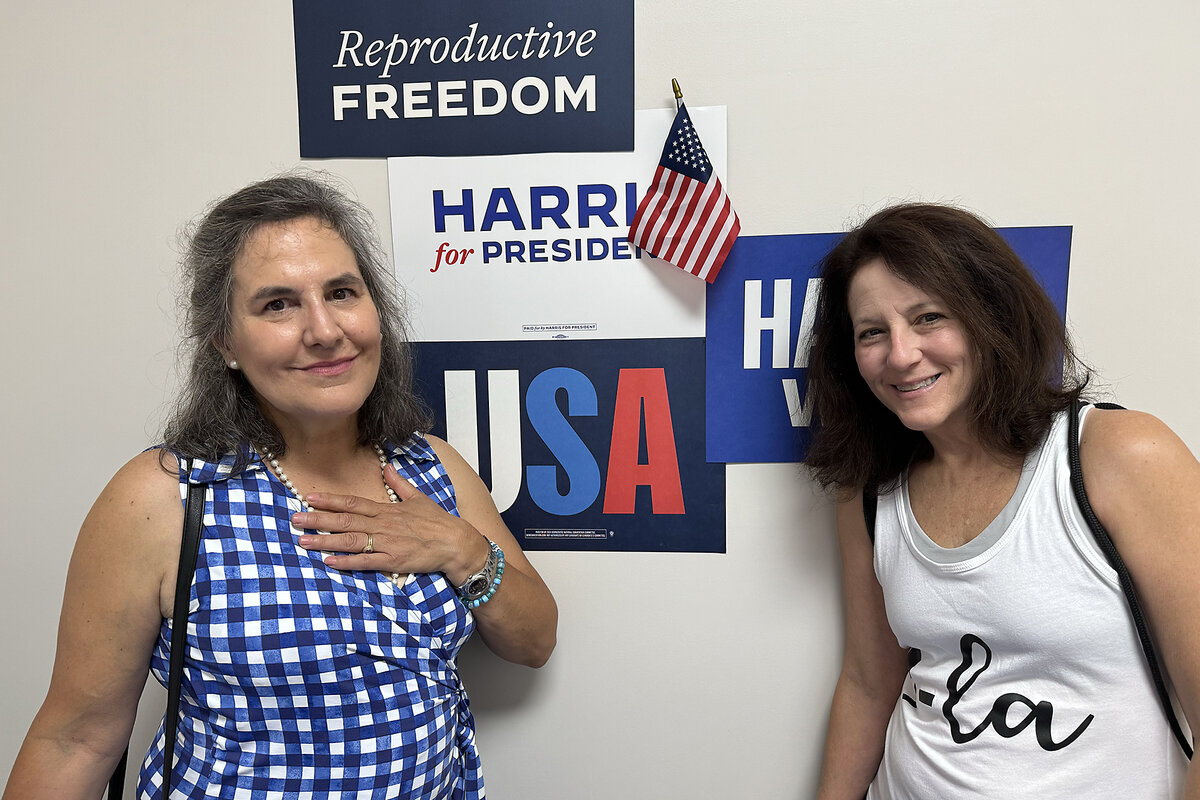
Dubious claims by both sides
Proponents of Amendment 4 hope the measure will drive turnout for Democrats, as the issue did in the 2022 midterms when an expected “red wave” did not materialize for Republicans. But a big difference now is that Mr. Trump is on the ballot, perhaps the biggest turnout driver for both sides.
Voters have faced a barrage of mailers and TV ads that may leave some confused. The most prominent opposition ad, sponsored by the Republican Party of Florida, attacks the amendment as vague and claims it would allow “abortion at any time.”
Experts note that the language of the amendment was approved for inclusion on the Florida ballot by the state’s highest court on the basis of its clarity, and that existing definitions in Florida law, such as the meaning of “viability,” must be followed if the amendment passes.
A TV ad by supporters of Amendment 4 – claiming the Florida abortion law has no “real” rape or health exceptions – was rated “mostly false” by PolitiFact. The current Florida law does contain a health exception, and other Florida law requires exceptions for cases of rape and incest for up to 15 weeks of pregnancy.
Anna Hochkammer, executive director of the Florida Women’s Freedom Coalition and a leader on Amendment 4, agrees with Mr. DiPietro that the battle will be fought in the middle.
“The math is pretty straightforward in Florida to get to 60%,” Ms. Hochkammer says.
Her approach: Win about 85% of registered Democrats, two-thirds of independents, and 2 out of 5 Republicans. She knows it won’t be easy, especially as Florida has grown increasingly red. Registered Republicans (now 39%) surpassed Democrats (32%) as the state’s largest voting bloc in 2021.
“My working hypothesis is that Floridians, even Florida Republicans, tend to tack libertarian, and so they perceive referenda as a brake on their elected officials,” Ms. Hochkammer says. “You have to go out of your way to talk to the Republican voters who have every intention of splitting their ticket on this issue.”
Some Florida Republicans planning to vote for Mr. Trump and yes on Amendment 4 see no contradiction in their views.
“I don’t love all of Trump’s policies, but on foreign policy, I believe he projects a little more strength” than Ms. Harris, says Jared, a lawyer in Tampa who asked to withhold his last name. But on the abortion measure, he says, “I have little sisters, and I don’t want the government to police what women can do.”
Editor’s note: This article was updated Oct. 7, the date of its initial publication, with the latest status on judicial review of Georgia’s six-week abortion ban.

A French rape victim goes public. She makes ‘shame change sides.’
Gisèle Pelicot, a French rape victim, has turned down her legal right to anonymity and demanded her name be published. She is asking that rapists, not those raped, carry the burden of shame.

- Quick Read
- Deep Read ( 5 Min. )
Most often in France, a woman bringing a charge of rape will exercise her right to remain anonymous. But not Gisèle Pelicot.
She is at the center of an extraordinary court case that opened last month in which her husband is on trial for allegedly drugging and raping her repeatedly over a decade, and for soliciting 50 other men to engage in sexual acts with her while she was unconscious.
By revealing her face to society and forcing the French to face up to what happened to her, Ms. Pelicot is changing public perceptions of what it means to be a victim. Many people here are calling her a feminist icon.
“By showing her face ... she’s asking people to look at what’s going on and make shame change sides,” says Elsa Labouret, a women’s rights activist. “She portrays someone who no longer has to carry that shame.”
She is turning the tables in other ways, too. “Mr. Pelicot had to drug his wife to make her submissive. But by taking her case public, she is no longer submissive,” says Caroline Legendre, a Paris-based psychologist who has worked with both victims and perpetrators of sexual assault. “She is active and the principal actor in her story.”
A French rape victim goes public. She makes ‘shame change sides.’
As Gisèle Pelicot enters the Avignon courtroom where her husband and dozens of co-defendants are on trial for raping her, she is often welcomed by applause from crowds outside. A woman of a certain age, Ms. Pelicot stands tall, sporting a stylish bob and sunglasses. She is not afraid to look her alleged rapists in the eye.
Ms. Pelicot is not a typical rape victim. On Sept. 2, her husband, Dominique Pelicot, went on trial over charges of drugging and raping her repeatedly over a decade, and for soliciting 50 other men to engage in sexual acts with her while she was unconscious.
The violence and scale of the crimes have shocked France. But instead of remaining anonymous – a right that French victims of rape typically exercise – Ms. Pelicot has opened her trial to the public and the press, asking reporters to publish her full name.
In revealing her face and forcing people to confront her husband’s acts, Ms. Pelicot is changing public perceptions of what it means to be a victim. Many here are calling her a feminist icon.
But the larger question is just how much influence Ms. Pelicot’s daring act will have on France. Does she herald a sea change in how rape and rape victims are treated in French society? Or will the specifics of her story prove too narrow to have a lasting effect?
“Gisèle Pelicot has become a figurehead of what we hope is a turning point in sexual violence cases,” says Elsa Labouret, a spokesperson for the women’s rights group Osez le Féminisme. “By showing her face and refusing a closed trial, she’s asking people to look at what’s going on and make shame change sides. She portrays someone who no longer has to carry that shame.”
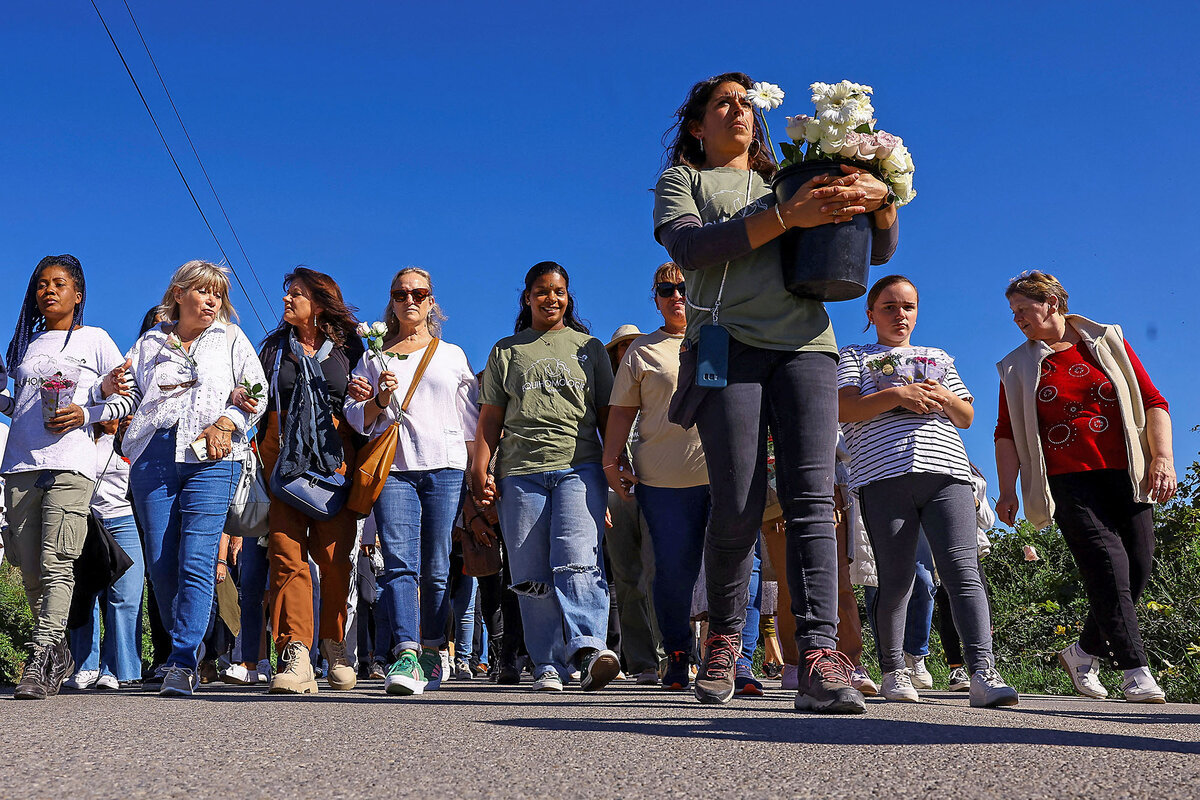
“We are all Gisèle”
French police first investigated Mr. Pelicot in 2020, when he was arrested for allegedly filming up women’s skirts in a supermarket. When the police opened his computer hard drive, they found more than 20,000 images and videos of apparent sexual assaults he and others had committed against Ms. Pelicot between July 2011 and October 2020 while she lay listless.
At the start of the trial that is expected to run until December, Mr. Pelicot told the courts, “I am guilty of what I did.” He admitted to drugging his wife with sleeping pills and antianxiety medications, and raping her two or three times a week. He claimed that the 50 accused men he solicited online to engage in sex acts were fully aware of what they were doing.
Despite the horror of the crimes, Ms. Pelicot has, from the outset, shown up to court each day to observe often crude witness testimony and video evidence involving events she wasn’t conscious of. Her poise and courage pushed thousands of women’s rights supporters into the streets of France in mid-September, with signs reading, “We are all Gisèle.”
“When it comes to sexual violence – especially domestic violence – there is a feeling that this is a private affair that should remain behind closed doors,” says Janine Bonaggiunta, a Paris-based lawyer who specializes in domestic violence. Victims of sexual assault have the right to keep their identity private during criminal proceedings in France, and most, she adds, exercise that right. “There are always fears of a backlash, threats, and harassment.”
Ms. Pelicot has had to draw on her courage to defend herself. Lawyers have challenged her in court about photographs depicting her conscious and intimate with her husband, or walking nude in her bedroom. “I feel like I’m the guilty one, and the victims are sitting behind me [in court],” she said about the co-defendants during the trial.
That’s a common experience for victims of sexual assault in France. Police officers are poorly trained to handle sexual assault complaints, and over 80% of cases – and 91% of rape complaints – are thrown out before coming to trial.
Experts say the stereotype of sexual assault victims – a woman in provocative clothing who was perhaps consuming alcohol or “asked for” the abuse – often deters victims from coming forward.
Sarah Hunt was living in Paris in 2011 when she went out with friends and woke up the next morning in a hallway of an apartment that wasn’t her own, with bruises on her inner thighs. After consulting with friends and doctors, she realized she had been drugged and sexually assaulted. She took her case to court, and eventually won it. But because she had consumed alcohol the night before, she often felt as if she was the one on trial.
During a court-ordered psychiatric evaluation, Ms. Hunt says the psychiatrist told her, “‘I think you drank too much and don’t want to admit that something happened.’”
“It was terrible,” says Ms. Hunt, who has since moved back to the United States. “He asked me so many questions about my family, anything about my childhood that would make me seem like a crazy person.”
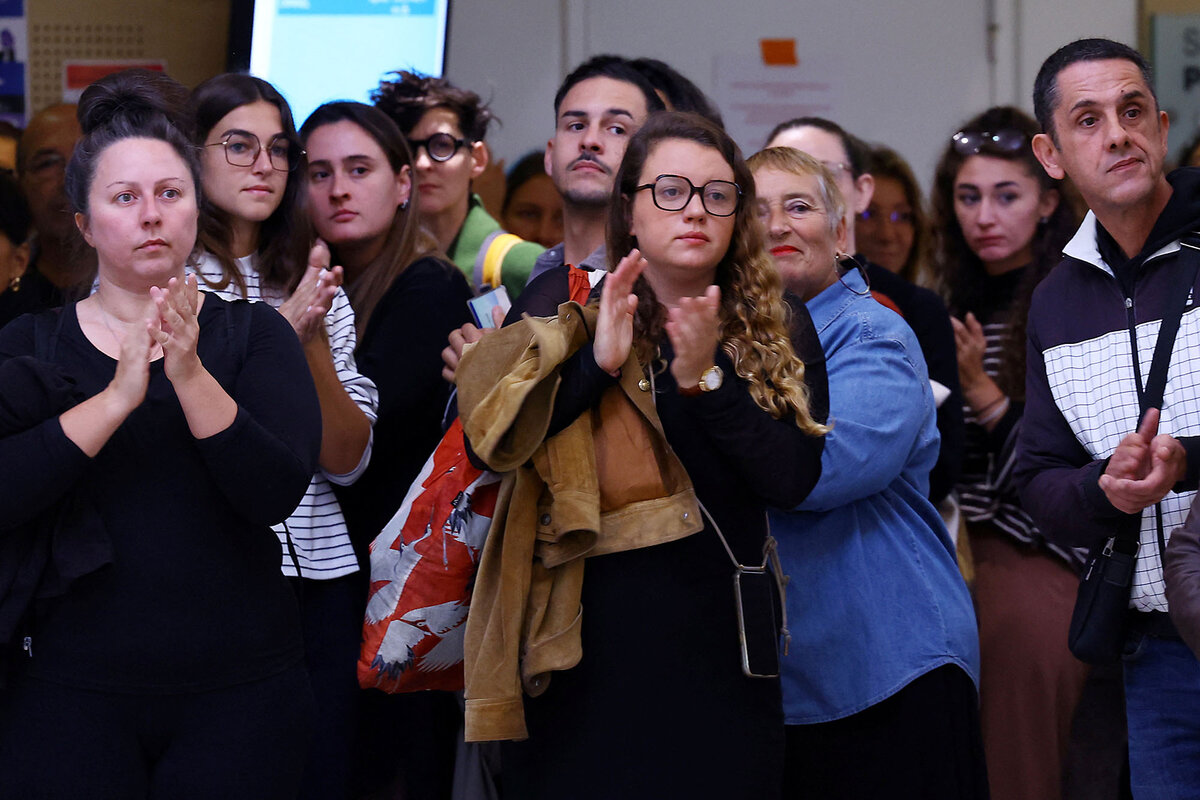
“She is no longer submissive”
On Friday, Ms. Pelicot said that she had won “a victory,” after a judge allowed video evidence of her abuse to be released to the public.
“This trial shows us the current rape culture, which involves domination, possession, and, especially, submission,” says Caroline Legendre, a Paris-based psychologist who has worked with both victims and perpetrators of sexual assault. “Mr. Pelicot had to drug his wife to make her submissive. But by taking her case public, she is no longer submissive. She is active and the principal actor in her story.”
Ms. Pelicot’s supporters hope that her courage will spread, even if her particular circumstances make her the “ideal victim.” Her choice to go public may affect the results of the trial, which is being held without a jury.
For survivors of sexual assault, like Ms. Hunt, Ms. Pelicot’s case changes the narrative of sexual assault crimes, a narrative usually owned by the attacker. And that, she says, is paramount.
“It’s so empowering to hear a victim’s name. Gisèle Pelicot isn’t afraid to say what happened to her,” says Ms. Hunt. “When you’re a victim of sexual violence, you lose your power. [Ms. Pelicot] is showing us how to take that power back.”

Hurricane Milton: Even a sea turtle is part of Tampa’s evacuation
As Hurricane Milton barrels toward Florida, the first priority is on readying humans for its impact. Amid the preparations, scientists are also tending to animals in their care.

- Quick Read
- Deep Read ( 4 Min. )
With Hurricane Milton churning across the unusually warm waters of the Gulf of Mexico – and aimed directly at the west coast of Florida – hundreds of thousands of Floridians are leaving their homes, following mandatory evacuation orders.
Meanwhile, in the town of Apollo Beach, scientists and veterinarians have been scrambling to save thousands of at-risk coral, plus a single sea turtle already displaced once by extreme weather, and now at risk again.
These may seem like small endeavors compared with larger storm preparations that are primarily about human safety. But they are reminders both of the wide-ranging activities threatened by the storm – as well as the compassion that people are showing in the face of it.
Sea turtle biologists rescued Calintina after Hurricane Helene hit Florida less than two weeks ago. On Tuesday, biologists moved the turtle from a sea turtle rehabilitation center in Apollo Beach to the Tampa campus of The Florida Aquarium. Although also in the predicted line of the hurricane, that facility has more protection, as well as engineers and veterinarians who will be riding out the storm with the animals.
“It’s been quite a wild ride for this turtle,” says Lindsey Waxman, staff veterinarian at The Florida Aquarium.
Hurricane Milton: Even a sea turtle is part of Tampa’s evacuation
With Hurricane Milton churning across the unusually warm waters of the Gulf of Mexico – and aimed directly at the west coast of Florida – hundreds of thousands of Floridians are leaving their homes, following mandatory evacuation orders. State officials are scrambling to remove debris left from Hurricane Helene, while search and rescue teams have arrived, ready to help with what they fear could soon be a disaster zone.
Meanwhile, in the town of Apollo Beach, scientists and veterinarians have been scrambling to save a single sea turtle already displaced once by extreme weather, and now at risk again. They have also been working to evacuate thousands of coral.
These may seem like small endeavors compared with larger storm preparations that are primarily about human safety. But they are reminders both of the wide-ranging activities threatened by the storm – as well as the compassion that people are showing in the face of it.
“The threat we humans in Florida are currently facing with a looming hurricane is similar to the ongoing threats many marine animals face in their environment on a daily basis,” says Debborah Luke, senior vice president of conservation at The Florida Aquarium in a text message. “Humans are a part of nature, not apart from it, and the compassion we provide to the animals in our care is no different than what we strive to provide for our friends and community. We are all connected, and by working together, we can make an ocean of difference.”

Residents spotted the turtle, which has been named Calintina, after it had been washed ashore during a storm surge caused by Hurricane Helene – a storm that was responsible for at least 227 deaths throughout the southeastern United States, and which damaged neighborhoods along the Gulf Coast near St. Petersburg.
A handful of local aquariums and nonprofit organizations are permitted by the U.S. Fish and Wildlife Service to rescue and rehabilitate these endangered marine reptiles. In this case, sea turtle biologists and veterinarians from the Clearwater Marine Aquarium’s rescue and rehab team helped retrieve the turtle and then worked with colleagues from The Florida Aquarium to transfer it to its Sea Turtle Rehabilitation Center in Apollo Beach.
But it soon became clear that the juvenile turtle would need to move again. The Apollo Beach center, with its open walls and multiple rehabilitation pools, is not hardened to withstand a storm the likes of Milton.
“I think it’s been quite a wild ride for this turtle,” says Lindsey Waxman, staff veterinarian at The Florida Aquarium. “Starting out in the wild, riding through a hurricane, stranding in a ditch, and then getting rescued by Clearwater Marine Aquarium … and then to come here just in time to start rehab, start diagnostics and treatment, and then just get packed up again.”
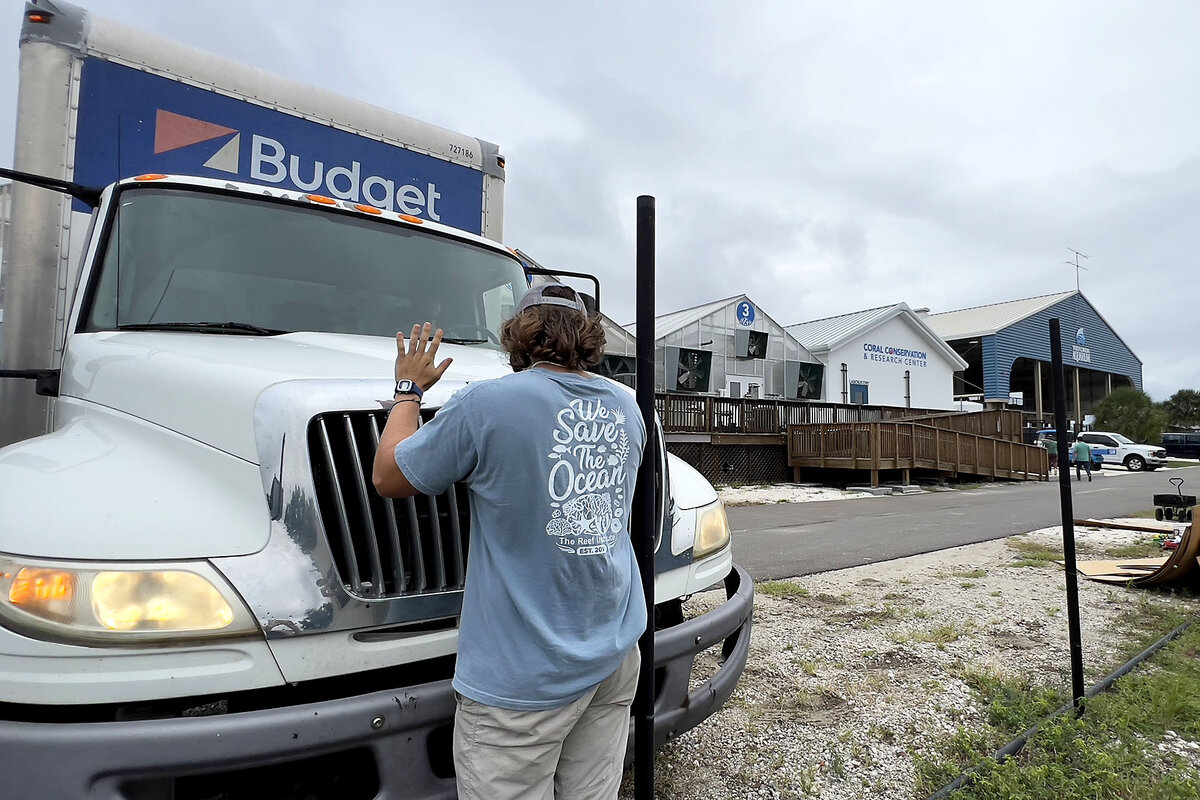
The staff biologists moved the turtle to the Tampa campus of The Florida Aquarium. Although also in the predicted line of the hurricane, that facility has more protection, as well as engineers and veterinarians who will be riding out the storm with the animals.
As the warnings for Milton increased, a team of scientists also worked to move more than 4,000 coral juveniles from the Apollo Beach facility to partners on Florida’s east coast and in Georgia.
“These corals, including some rescued from last summer’s marine heatwave in the Florida Keys, are part of a broader initiative to safeguard species crucial to marine biodiversity,” The Florida Aquarium said in a press release, noting it’s the “only facility in the world to care for endangered pillar coral and holds the largest number of reproductive size elkhorn coral, and numerous colonies of both species are being evacuated.”
Earlier today, Calintina arrived safe and sound to the secure second floor of The Florida Aquarium’s Tampa campus.
Meteorologists predicted the storm to make landfall late Wednesday night. The National Hurricane Center is warning of up to 15 feet of storm surge.
Read more on Hurricane Milton: Why is Tampa so vulnerable to a large hurricane? While Floridians are no strangers to storms, Tampa hasn’t been in the direct path of a major hurricane in over a century. It has a huge population now facing an evacuation order.

Dropping the ‘senior’ in senior center
Senior centers are evolving into active, modern cultural hubs to meet the needs of baby boomers and their Silent Generation predecessors who are living longer, more active lives.

- Quick Read
- Deep Read ( 7 Min. )
-
By Ashley Milne-Tyte Contributor
With the tail end of the baby boom hitting age 60 this year, and the other end of the older age spectrums expanding as longevity increases, the American institution of senior centers is evolving dramatically.
The nation’s 11,000 senior centers are rebranding, growing, and redesigning spaces and programs to serve what now is effectively two generations between the ages of 60 and 100.
The new model for senior centers is a lively hub for a variety of older people. Bingo and card games aren’t gone, but if you think that’s all a senior center offers, think again. Indeed, think: speed dating, pickleball, tech labs, song and dance, cooking classes, therapy dogs, and … ditching the word “senior” altogether.
“We have this huge generational shift where senior centers that were created by the Greatest Generation were carried on for the Silent Generation,” says Dianne Stone, associate director of network development and engagement at the National Council on Aging’s Modernizing Senior Centers Resource Center. “But there’s this new generation pushing in from behind, and it changes the way that we do things.”
Dropping the ‘senior’ in senior center
Ask many of today’s 60-, 70-, or even 80-somethings if they go to a senior center and they’ll probably grimace at the staid reputation of that institution of American old age – people silently watching TV, shuffling cards, picking up a mushy-looking meal, or minding their bingo chips.
But shifting demographics – namely, baby boomers living longer, more active lives – are driving an evolution of senior centers that now effectively serve two generations between the ages of 60 and 100.
There are an estimated 11,000 senior centers in the United States according to the National Council on Aging (NCOA). It reports a new dynamism and broader sense of purpose driving the change – from redesigning buildings to expanding services for active older people.
“We have this huge generational shift where senior centers that were created by the Greatest Generation were carried on for the Silent Generation,” says Dianne Stone, associate director of network development and engagement at the NCOA’s Modernizing Senior Centers Resource Center. “But there’s this new generation pushing in from behind, and it changes the way that we do things.”
Bingo and card games aren’t gone, she says, but if you think that’s all a senior center offers, think again. Indeed, think: speed dating, pickleball, tech labs, song and dance, cooking classes, therapy dogs, and … ditching the word “senior” altogether.
Rebranding active old age
Dropping the word “senior” is part of a rebranding trend.
The Thrive55+ Active Living Center in Groton, Connecticut – formerly the Groton Senior Center – did this last year. It expanded its footprint to 35,000 square feet more than a decade ago because, says program supervisor Kathy Williams, the center had a growing number of users and not enough space to accommodate them.
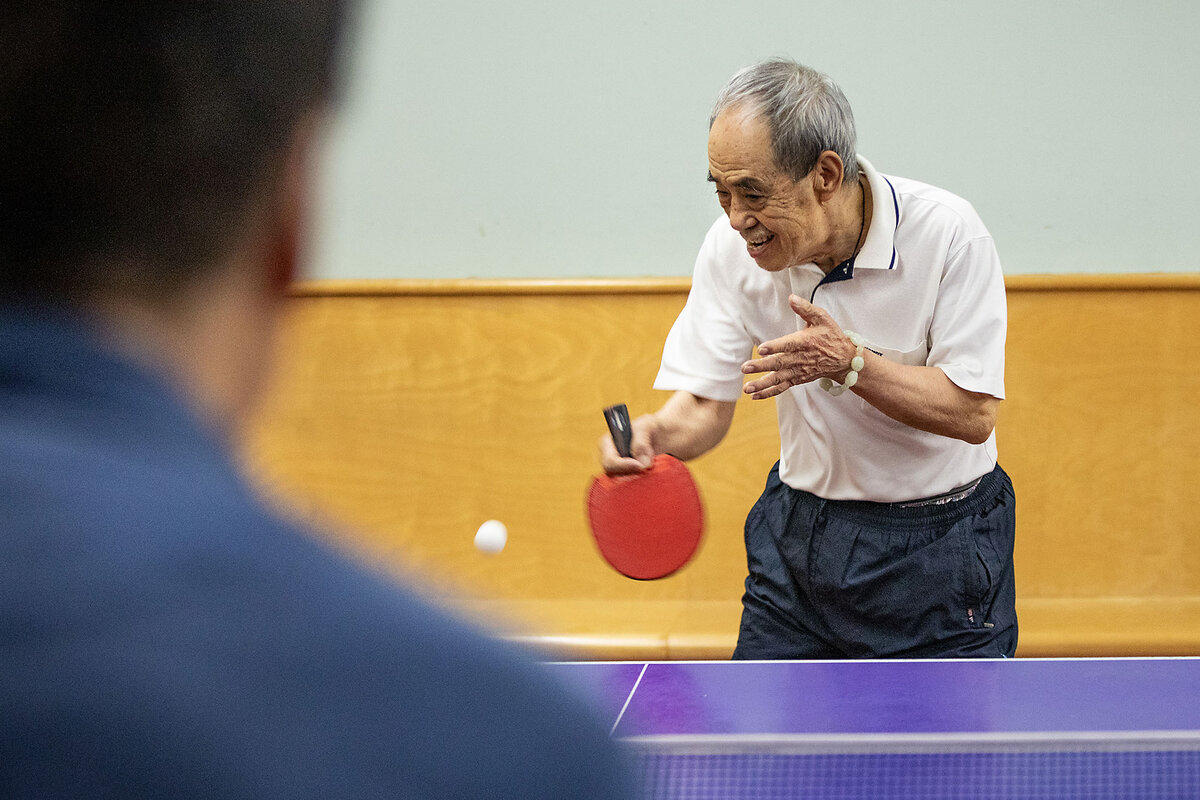
But the pandemic hit senior center attendance hard. Ms. Williams says as the center reopened and staff worked out how to draw people back, they realized it was not attracting everyone it could. There were plenty of local people who had never set foot there, even before the pandemic.
So early in 2023, after consultation with the community and longtime users, the center changed its name.
“The nonusers didn’t like the name ‘senior’ because it made them feel old,” says Ms. Williams. Meanwhile, the center wanted its name to convey what users reported they were doing: thriving.
The word “senior” doesn’t deserve its negative connotations, says Ms. Stone, of the Modernizing Senior Centers Resource Center.
“The problem we have is not with the name ‘senior center,’” she says. “It’s with the stigma and ageism that surround the name ‘senior center.’”
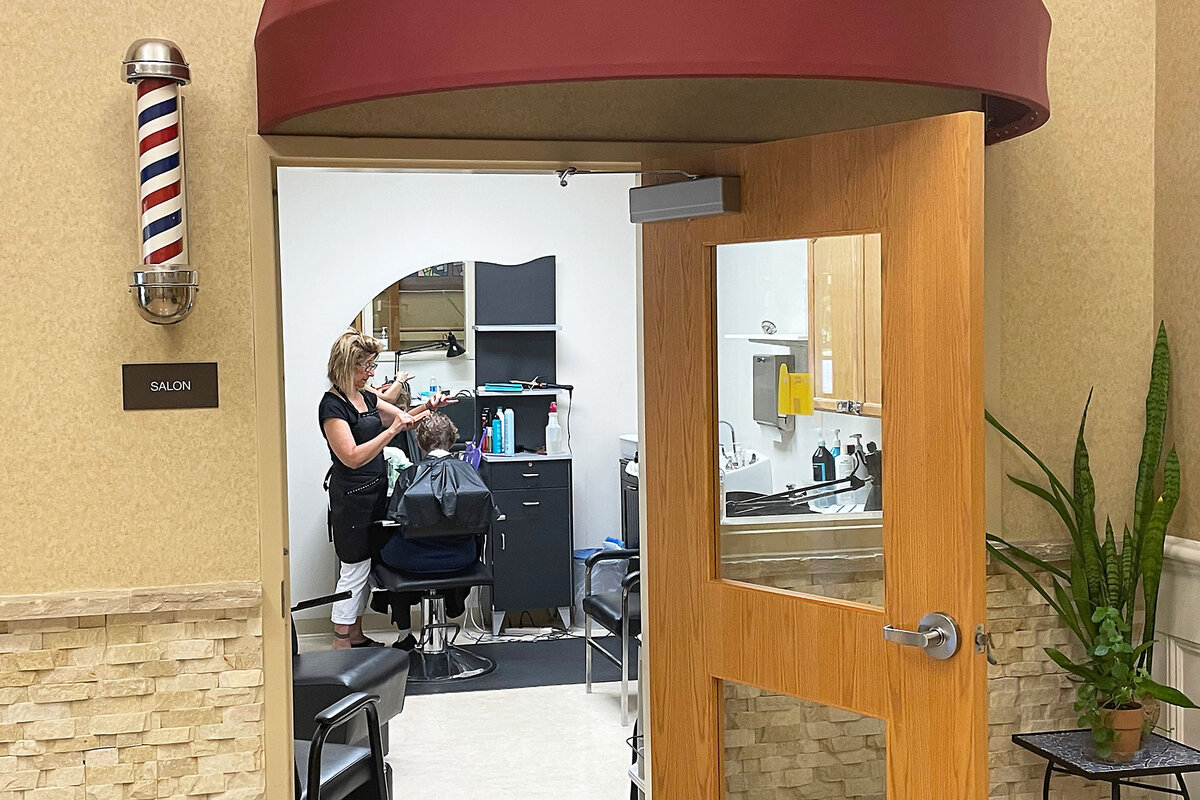
In the case of Thrive55+, the change had its desired effect, says Ms. Williams. More people have come through the doors who just needed to see and experience the place in order to inspire them to come back.
Thrive55+ has a technology lab, multiple fitness rooms, a hair salon, and a café. It began art classes at the request of multiple patrons, and the watercolor class now has a waiting list. Lately, it’s gotten into gardening: The center has a series of raised beds on its grounds, where teams of volunteers tend vegetables and herbs, which are then used by the kitchen staff in preparing the daily three-course lunch, which costs $6.
Anna Arder, a retired computer scientist using the printer in the tech lab, says a meal of the same quality would cost “at least $25” at a local restaurant. She describes Thrive55+ as “the Taj Mahal of senior centers.”
Speed dating, Elvis impersonators, and Bollywood dancing
A National Council on Aging survey of 400 centers nationwide found almost half reported they were planning to build or renovate in the next five years, says Ms. Stone.
Gleaming gyms are often a feature of redesigns, reflecting what Ms. Stone describes as baby boomer interest in maintaining their health.
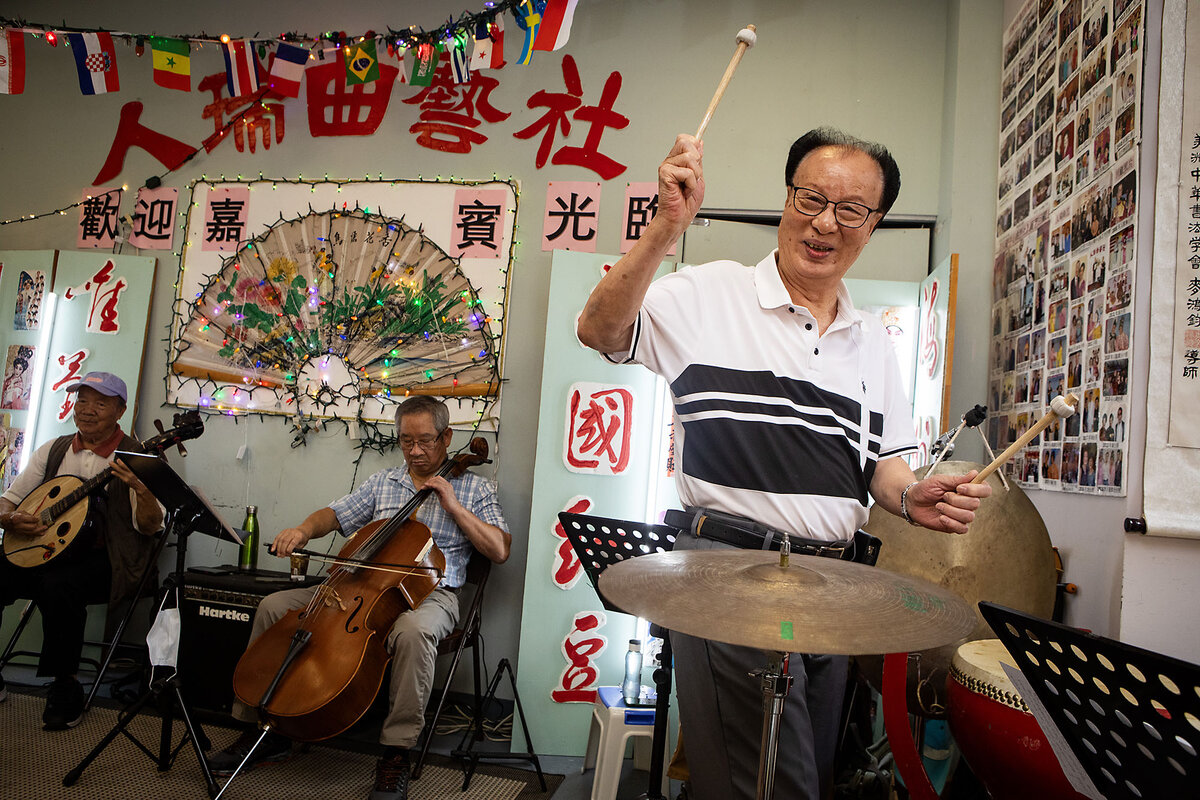
One rebuilt center in Portage, Michigan, has a fitness center and pickleball courts in a state-of-the-art building. It also offers more unusual fare. Since its opening in 2022, in addition to offering speed dating, it has hosted a mass renewal of wedding vows presided over by an Elvis impersonator.
Membership more than doubled at the facility. “Newly constructed or renovated centers invariably report surges in their participation,” says Ms. Stone.
Other centers offer sessions with therapy dogs, and classes in cooking for one and Bollywood dance, to name a few.
Some centers just listen to what clients want
For some, modernization means something other than a renovation or new activities. Attracting a more diverse user base, for instance, by signaling to the community that a center is friendly to LGBTQ+ people or it focuses on diverse cultures.
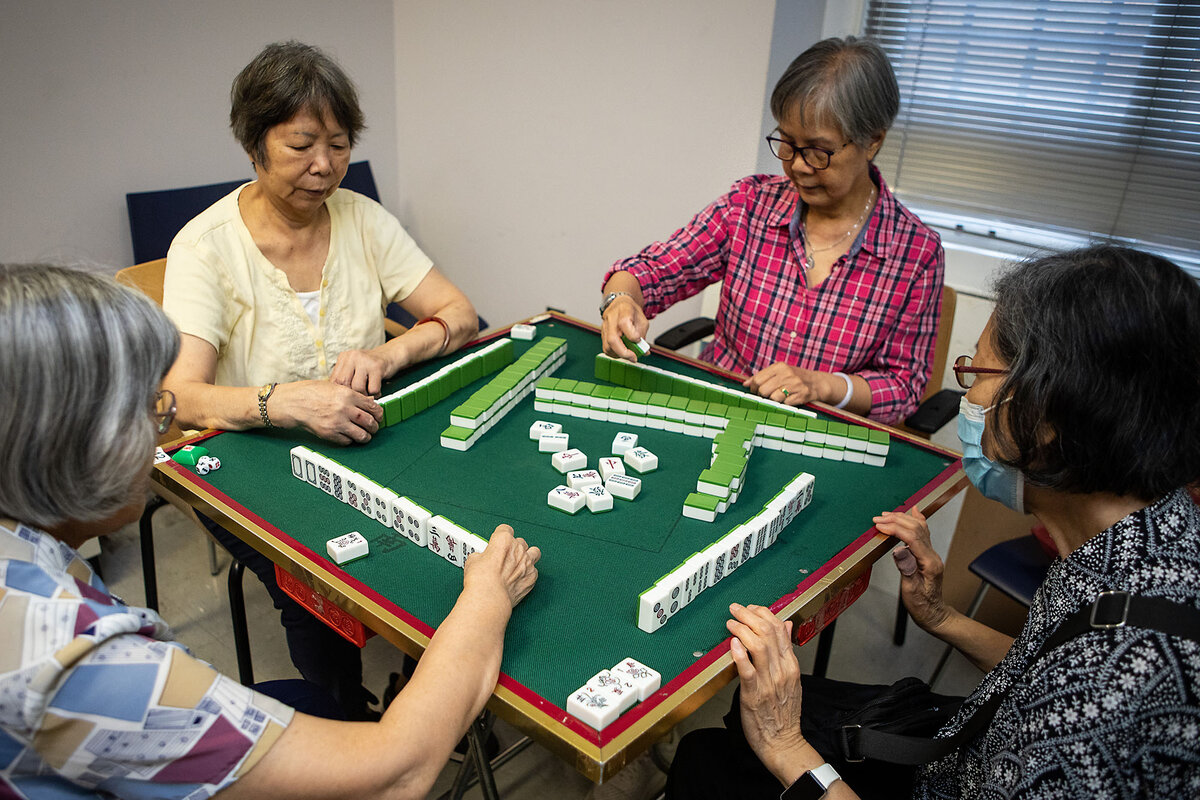
The Open Door Senior Center, a hive of activity in New York’s Chinatown, is a case in point. While it has not rebranded, it makes a conscious effort to adapt its programing to what membership – 60% of which is over 80 years old – wants. The result is a lively space in which younger members have asked for and gotten “bone-in” meat in soup (the flavor is better) and can satisfy their curiosity about the arts by attending public performances in the city.
The rhythmic vocals of members singing Chinese opera float through the halls, down which you can also hear the click of mah-jongg tiles, the twang of the qinqin – a Chinese lute – and the hollow ”pock’” of table-tennis balls being batted back and forth. Woven through it all are the rising and falling tones of Cantonese, Mandarin, and Fujianese as scores of center members come and go throughout the day.
In the table tennis room, fans whir while pairs of players in their 70s and 80s dart at the ball, exclaiming in Cantonese while working up a sweat.
Stephen Chen, a retired postal worker in his late 80s, sits on a bench along with several others, perusing a Chinese-language newspaper and waiting for his next turn to play.
“We all come here to play pingpong and see friends and talk to people,” he says. “It’s very important people keep talking” as they get older, he adds, socializing with others. He lives with family members, but says coming here gives him a boost he can’t get elsewhere.
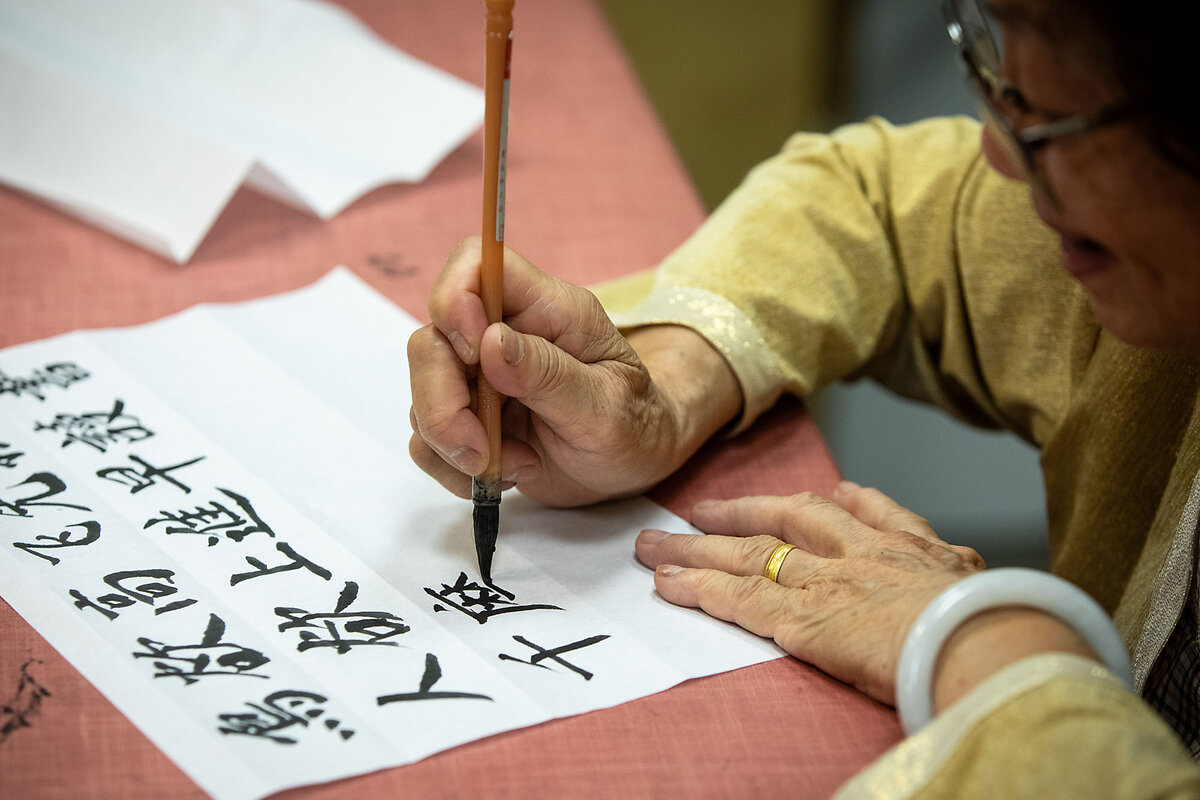
Many of New York’s ethnically Chinese older adults are lower-income, and never learned to speak English well, if at all. But their lives here are rich. They come not just to meet up with friends and neighbors but to connect with their culture, eat the food they grew up on, and challenge themselves both physically and mentally with everything from technology classes to tai chi.
Clients of this center range in age from 60 to 107, which means designing programs for two generations. Po-Ling Ng, Open Door’s director, says older members are likely to enjoy Chinese cultural pursuits, including games like mah-jongg. Younger ones want other activities – such as American and Latin American dance, and trips to cities like Washington – thrown in. Food is a unifying force, and a hot lunch is served each day for 50 cents. Everyone enjoys meals like Shaoxing curry chicken balls and bean and cauliflower with sliced pork.
Ms. Ng has lived in the United States since her 20s and is now in her early 80s. She believes the key to a healthy lifestyle, regardless of age, is staying engaged with the world around you.
“I said to the seniors, if you want to improve your life, you should keep learning: learning by doing, doing by learning,” she says.
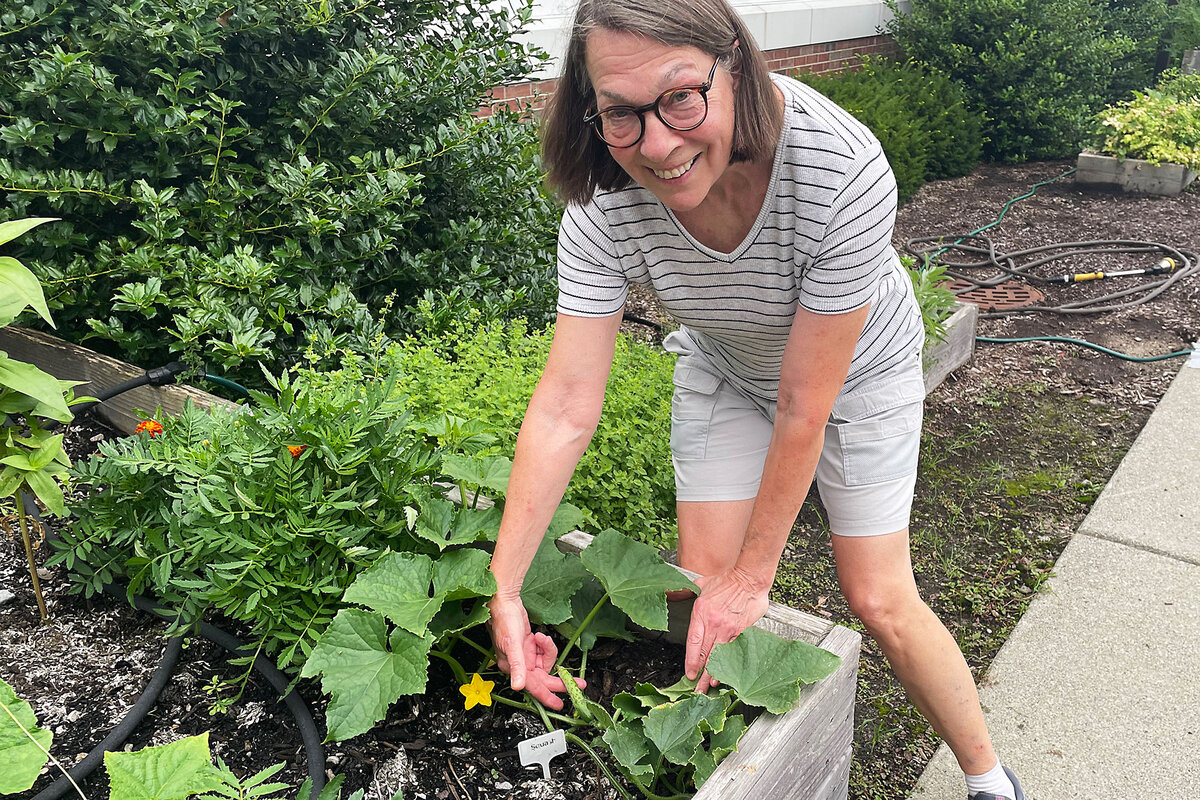
A senior center by any other name ...
Back at Thrive55+ in Groton, Liz Carlson is also keen to stay active. A retired kindergarten teacher in her 60s, Ms. Carlson sits on a bench with friends outside a fitness room, leaning on a cane, waiting for a seated exercise class to begin.
“We got it all going on here!” she says, adding that her 95-year-old mother also attends.
She rolls her eyes at the rebranding. As far as she’s concerned, she says, “It’s still the senior center.”
Other headline stories we’re watching
(Get live updates throughout the day.)The Monitor's View
The kindly calm after a storm
- Quick Read
- Deep Read ( 3 Min. )
-
By the Monitor's Editorial Board
When the rainy remnants of Hurricane Helene slammed into western North Carolina in late September, they swelled the river running through Asheville into a destructive torrent. Yet the flooding also quickened many social back eddies. The storm brought out Asheville’s “communitarian spirit,” said one resident. Another said that it had “made people humble.”
The neighborly responses shaping Asheville’s recovery will be familiar elsewhere in the storm’s path. Already hit by Helene, residents in Florida are now bracing for the arrival of Milton. Around the world, the greater impact of natural disasters from floods to wildfires is forcing communities to find social and physical resilience, which compels higher trust and compassion.
“In communities characterized by strong trust, solidarity, and active participation, responses to disasters tend to be more effective,” noted a recent study. “Residents in such communities are inclined to assist neighbors in need by sharing resources, providing shelter, offering financial support, aiding in disaster preparedness through early warning information, and providing emotional support.”
The study found that “fostering a robust sense of concern” reduces the cost of risk and sense of vulnerability. It can also turn recovery efforts into creative opportunities that enhance equality and good governance.
The kindly calm after a storm

When the rainy remnants of Hurricane Helene slammed into western North Carolina in late September, they swelled the river running through Asheville into a destructive torrent. Yet the flooding also quickened many social back eddies. The storm brought out Asheville’s “communitarian spirit,” one resident told The New York Times. Another told The New Yorker that it had “made people humble.”
More affluent residents turned to serve those less fortunate, according to many reports. Political differences that might otherwise be pronounced dissolved as people helped one another.
“We know God’s truth and we know God loves Western North Carolina, so while this tragedy surprised us, we’ve been able to see so much life change and so much redemption just through how He’s moved through our people,” Devin Goins, an executive pastor at Biltmore Church, told the Asheville Citizen-Times.
The neighborly responses shaping Asheville’s recovery will be familiar elsewhere in the storm’s path. Already hit by Helene, residents in Florida are now bracing for the arrival of Milton, Around the world, the greater impact of natural disasters from floods to wildfires is forcing communities to find social and physical resilience, which compels higher trust and compassion.
“In communities characterized by strong trust, solidarity, and active participation, responses to disasters tend to be more effective,” noted a recent study published in the International Journal of Environmental Research and Public Health. “Residents in such communities are inclined to assist neighbors in need by sharing resources, providing shelter, offering financial support, aiding in disaster preparedness through early warning information, and providing emotional support.”
The study found that “fostering a robust sense of concern” reduces the cost of risk and sense of vulnerability. It can also turn recovery efforts into creative opportunities that enhance equality and good governance.
A series of earthquakes that leveled buildings in Turkey last year, for example, exposed corruption in the construction sector. The recovery effort has included calls for greater transparency, accountability, and public education of civic values.
In Hawaii, where a wildfire hit the coastal town of Lahaina last year, residents are rebuilding more than their homes and shops. Restoring community involves restoring wetlands destroyed by past commercial sugarcane farming and healing the social resentments it fostered. “Right now, believe it or not, even though people say our town is gone, I look at it as the opposite,” one community leader, Keeaumoku Kapu, told The Washington Post.
Natural disasters often bring out the best in people far and wide to meet the needs of those in distress. In Asheville, church groups from St. Louis arrived with food and shovels. Rescue crews came from Colorado and Ohio to help local first responders check in on isolated residents. Local musicians have put down their instruments and picked up chain saws.
“We have two choices,” Darren Nicholson, a mandolin player in a bluegrass band, told Rolling Stone. “We either sit around and dwell on the problem or we can get into the solution.” That spirit of neighborliness turns seasons of vulnerability into seasons of trust and resilience.

A Christian Science Perspective
Each weekday, the Monitor includes one clearly labeled religious article offering spiritual insight on contemporary issues, including the news. The publication – in its various forms – is produced for anyone who cares about the progress of the human endeavor around the world and seeks news reported with compassion, intelligence, and an essentially constructive lens. For many, that caring has religious roots. For many, it does not. The Monitor has always embraced both audiences. The Monitor is owned by a church – The First Church of Christ, Scientist, in Boston – whose founder was concerned with both the state of the world and the quality of available news.
Does progress require process?
- Quick Read
- Read or Listen ( 3 Min. )
-
By Moriah Early-Manchester
Recognizing that the kingdom of heaven is a present reality frees us from constraints that would hamper productive steps forward, as a woman experienced during a job search.
Does progress require process?
We frequently encounter the common assumption that healing, that progress of any kind, is dependent upon a process. Whatever the specific process may be, it always involves steps leading to a goal or end. But this can be very limiting when it is dependent primarily on matter-based predictions of how events will play out over a given period of time.
However, cutting through the limitations of material processes is possible with prayer that brings thought into alignment with God’s perfection.
In the Gospel of John, Jesus gives this beautiful promise that directly contradicts the assumption that progress requires a process: “Say not ye, There are yet four months, and then cometh harvest? behold, I say unto you, Lift up your eyes, and look on the fields; for they are white already to harvest” (4:35).
Elaborating on this promise, Mary Baker Eddy, the discoverer of Christian Science, states in her book “Unity of Good,” “Jesus required neither cycles of time nor thought in order to mature fitness for perfection and its possibilities. He said that the kingdom of heaven is here, and is included in Mind; that while ye say, There are yet four months, and then cometh the harvest, I say, Look up, not down, for your fields are already white for the harvest; and gather the harvest by mental, not material processes” (pp. 11-12).
A particular process most of us encounter at one time or another is the job search. But I have been learning that even finding a job doesn’t have to be a process. When I felt impelled to follow a deep desire to pursue employment based in my love for Christian Science and its healing mission, I trustingly gave my notice to my employer, even though I didn’t have another job lined up.
My prayers during this time were often guided by this verse from a hymn in the “Christian Science Hymnal”:
Truthful and steadfast though trials betide thee,
Ever one thing do thou ask of thy Lord,
Grace to go forward, wherever He guide thee,
Gladly obeying the call of His word.
(P.M., No. 278, adapted, © CSBD)
Even though I didn’t immediately get a new job, there were so many instances of God’s grace and guidance along the way, opening door after door and compelling me to walk forward. This led to expansive and enriching experiences that enabled me to discover more of God’s grandness, beauty, and love.
The book of Matthew records Jesus as saying, “The kingdom of heaven is at hand” (4:17). The kingdom of heaven – the reign of divine harmony – is here and now, not existing in some distant location or arriving at some future date. Jesus’ healing ministry bore witness to the ever-presence of spiritual reality, and that brought the needed change to the lives of those he healed, not incrementally but immediately. God’s goodness is ever present; Deity doesn’t delay or procrastinate.
Shortly after notifying my employer that I would be leaving, I applied for a job that appeared to be a perfect fit for me. The application process lasted for several months, and in the end, I didn’t get the job. My initial reaction was disappointment. But less than a week later, I was unexpectedly hired immediately for a job that required no application process and that nurtured my love for spiritual healing.
Healing is not a process but a revealing of what always has been and always will be true about God’s spiritual creation and our completeness as God’s reflection. Prayer lifts our thoughts above limited, ego-based views to see the reality of things as God sees them – wholly good, purposeful, orderly, and harmonious.
The kingdom of heaven, in which God’s laws of health and harmony are ever present and active, is already at hand. Our lives are not reliant on material processes but on eternal, spiritual unfoldment, peeling away limited, material thinking and revealing the universal presence and supremacy of Spirit, God, and His perfect creation. Every day is an opportunity to witness more of the perfection that is already innate to each of us.
We are always progressing, and our Father-Mother God, divine Love, is unfolding each step, revealing to each of us a more expansive sense of identity, purpose, and health.
Adapted from an article published in the June 21, 2021, issue of the Christian Science Sentinel.

Viewfinder
Prep time

A look ahead
We’re so glad you spent time with us today. We have one more story for you – a bonus read from Air Force Two. Linda Feldmann traveled with Kamala Harris as she barnstormed two must-win states and began a media blitz. How did it go? Please read the story here.



